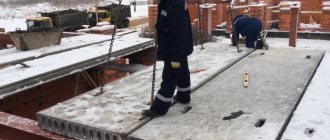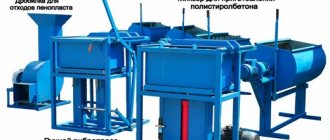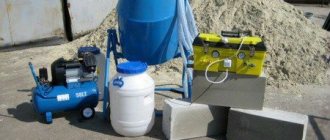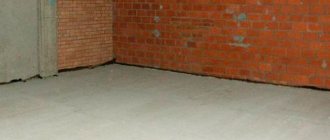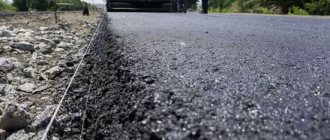The most popular method of covering roads and sidewalks, which meets modern concepts of high-quality coating and the price of which, moreover, is relatively low, can be called asphalt paving. But in addition to the mixture itself, the reliability and efficiency of installation depends approximately 50% on the preparatory work, that is, on the pillow that serves as a rough base for the front layer.
Below we will talk about the technology of this production, and also pay attention to the demonstration of a thematic video in this article related to our topic.
Laying asphalt concrete pavement with an asphalt paver
When can asphalt be laid?
According to the latest rules (2012 edition), asphalt can be laid in dry weather at temperatures from +5 degrees in spring and summer and from +10 degrees in autumn.
Interesting materials:
How to make a slice in Google Sheet? How to make links in Word content? How to make a link on Android? How to link to a person on WhatsApp? How to make a link to Donate in DonationAlerts? How to link to DonationAlerts? How to make a link to Excel? How to make a link to a file in Yandex disk? How to link to a file in Explorer? How to make a link to a Viber group on Instagram?
Asphalt on the road
Note. The name comes from the Greek ἄσφαλτος which implies mountain tar, where 60%-75% bitumen is mixed with minerals. In the artificial version, bitumen is limited in amount from 13% to 60%, and the filler is gravel/crushed stone, sand and mineral powder.
Production stages
- First of all, the technology for laying asphalt concrete mixtures, however, like other construction and installation works, depends on the layout, therefore, before starting production, a technical design and financial estimate must be drawn up . This is followed by markings in relation to the terrain features of the area in order to ensure the possibility of draining wastewater and underground and above-ground communications passing nearby. In addition, the presence of large trees with a developed root system is of great importance - if necessary, they are cut down so that problems do not arise in the future.
- At the end of the preparatory work, the top, wet layer of soil is removed using an excavator or bulldozer, where the depth will primarily depend on the operational purpose of the area . For example, for asphalting a sidewalk or garden paths, a depth of 10-25 cm is sufficient, but for a roadway this is, of course, not enough - the greater the planned load, the deeper the foundation will have to be laid.
- In addition, the technology for laying asphalt concrete implies the mandatory installation of a drainage system - water should not accumulate either on the surface or under it . In this regard, it is very important to remove all the soil that was removed during the preparation of the base, so that during the rainy season it does not wash away and clog the drainage system.
- After completing the excavation work, it is possible to lay asphalt on a concrete base (rigid pad) or on crushed stone (gravel) with sand (soft pad) and this again depends on the future degree of load during operation of the site according to SNiP 06.03-85 . For example, for pedestrian paths, the height of the sand-crushed stone cushion can be only 5-10 cm, but if this is a roadway with low traffic volume (entrance to a house or gate), then the height here will be 10 cm or more. Moreover, provided that heavy loads are expected during operation, the cushion is laid in layers - first gravel (fraction 40-60 mm), then crushed stone (fraction 20-40 mm), and on top of them - coarse river sand.
Note. In order to speed up the shrinkage of the cushion before laying the asphalt, it is watered generously. When the bedding shrinks, it also gains additional strength. Tamping is done with vibrating plates, rollers, and at home you can even do it yourself using a bit.
Concrete slabs for the base
- In cases where the roadway is subject to very intense traffic and, therefore, a large mechanical load, then concreting or laying reinforced concrete slabs is used for the base, as shown in the top photo . Due to the high cost of this type of coating, they are made extremely rarely in our country and, for the most part, such structures are limited to use for runways or test sites.
- It is most profitable to use construction waste as bedding - broken brick, stone, old broken slabs, blocks and floors, cement-sand plaster, and so on . It is noteworthy that with sufficient compaction of such materials, they are in no way inferior to the same crushed stone or gravel, while the cost of the cushion is sharply reduced - after all, garbage, instead of recycling it, is used as a building material. But here, of course, the labor intensity of the process increases significantly - after all, such waste, as a rule, has a very large fraction and because of this it is more difficult to compact it (it has to be broken).
Note. Laying the base (concrete or sand-crushed stone cushion) implies the presence of a flange, which is made of stones or special reinforced concrete curbs - this allows you to mold the future covering. In addition, the laying of asphalt also requires forming, therefore, the height of the curb must be designed for the face covering.
Laying technology
Laying asphalt on the base
Currently, asphalt laying in the Russian Federation is carried out in accordance with GOST 9128-2009 for asphalt concrete road and airfield mixtures, and the instructions given in this document are also applicable for laying such coatings privately (in dacha and suburban areas). Usually, asphalt concrete is ordered at the nearest point of its production - this is preferable to handicraft production.
There are quite a lot of asphalt plants, including small ones, so buying a ready-made mixture will cost much less than making it yourself, and besides, the proportions of State Standards are easier to comply with in continuous production than with one-time production.
It is important to consider that the air temperature outside must not be lower than 5ᶛC, and the production process must be carried out in dry weather - installation during rain is strictly prohibited! If these conditions are violated, the next year after laying, cracking and erosion of the coating will be observed, and the wear resistance of the asphalt will significantly decrease.
To calculate the amount of material consumed at a certain object, you will need to calculate the area of the site and determine its thickness - for a layer of asphalt 10 cm high and 10 m2 in area, one ton of solution will be needed.
Laying order and compaction
Laying asphalt on a crushed stone bed
The technology of laying asphalt on a concrete base or on a sand-crushed stone bed implies the completion of work without the slightest delay after the dump truck with the solution has arrived at the construction site - this is one of the most important facets of the requirements of GOSTs and SNiPs.
For large volumes, for example, a highway, during installation work special pavers and large self-propelled rollers are used, but when arranging the same sidewalks, it is necessary to use shovels and mops. In addition, small areas cannot always be compacted even with a small self-propelled roller, therefore, in such cases, vibrating plates are used.
If you carry out similar work on a personal plot, then you are unlikely to invite a designer there, but, nevertheless, you will have to adhere to certain parameters for the thickness of the coating. Therefore, for garden paths you can maintain a layer with a height of 3-4 cm, while for driveways (if parking of heavy vehicles is not provided there) a thickness of 5-7 cm will be required.
Modern methods of laying asphalt pavement
Asphalt belongs to the group of building materials intended for covering road surfaces.
Its main purpose is to create reliable safe conditions for organizing pedestrian or vehicular traffic. When properly laid, asphalt pavement can withstand heavy loads, this is facilitated by the grade of asphalt, which is legally established by GOST 11-10-75: M1200 - for roads, M1000 - for sidewalks and paths.
Asphalt is environmentally friendly, has a high level of practicality and an attractive appearance, is somewhat labor-intensive to manufacture and use, and is not the most expensive of road surfaces.
Technology for strengthening the surface layer of concrete
Ironing (strengthening) with cement is used exclusively by private developers and repairmen. At this point in time, there are more effective and easy-to-use industrial strengthening additives on sale. Nevertheless, the “old” technology of cement hardening is in demand and is in demand.
- The freshly poured, compacted and leveled concrete surface is sprinkled evenly over the entire area with Portland cement grade M400 or M500. The layer thickness is several millimeters;
- If necessary (very “dry” concrete), the surface is carefully sprayed with water until the cement is completely wetted;
- Using a spatula or a construction trowel, rub the cement into the concrete in a circular motion;
- Cover the surface with plastic wrap for 72 hours until completely set.
The physical meaning of this operation is as follows. Pure cement forms a high-strength crust on the concrete surface, which reliably protects the base from mechanical influences and harmful atmospheric factors: temperature changes, rain and snow. Moreover, since cement is a binder when preparing concrete, and is poured onto its surface that has not yet set, its 100% adhesion to the base is ensured.
Now let’s look at the so-called “ironization” of asphalt. In general, asphalt is a mixture of bitumen, crushed stone of different fractions, granulate and sand, heated to a certain temperature.
In this case, the binder is not cement, but bitumen. Accordingly, there can be no talk of any adhesion of cement poured onto the surface of asphalt to the base. Cement particles stick to the surface of the coating like ordinary dust, and a priori cannot strengthen it.
Do-it-yourself cold paving of asphalt
The technology for laying cold asphalt is much lighter and simpler than hot asphalt. The mixture is already sold ready-made in convenient bags and buckets. For installation you will need the following tools: hand roller, vibrating plate or hand tamper, mop.
- First you need to prepare the surface. Remove the top layer of soil 4-5 cm and add a layer of sand, then crushed stone and compact everything well.
- Pour the first layer of the mixture, level it with a mop and roll it with a hand roller or vibrating plate. If you don’t have these tools, you can get by with a manual tamper. Then you need to pause for 10-15 minutes and lay the second layer in this way. Three layers of asphalt show good strength indicators.
- After 24 hours the coating is ready for use.
When laying cold asphalt, it is important to compact it well to prevent water from getting into the cracks and then this coating will serve for a long time.
Ways to increase the strength of asphalt
At the beginning of the article, we looked at the main factors that influence this property of the material. It is with them that manufacturers and researchers work when designing ABS compounds.
Four groups of methods can be distinguished:
- Use of optimal raw materials
- Increased adhesion of the mixture
- Increasing the density of asphalt concrete
- Use of protective coatings
Let's look at each of them in more detail.
Use of optimal raw materials
The main component of asphalt concrete, which takes on the load from transport, is a mineral filler: crushed stone and sand (screenings). Accordingly, the strength of the coating can be increased if you use a material with higher performance for ABS.
GOST 9128-2013 establishes the following requirements for mineral components:
| Index | Breed type | Asphalt brand | ||
| I | II | III | ||
| Grade for crushability (for crushed stone), no less | Igneous and metamorphic | 800-1200 | 600-1000 | 600-800 |
| Sedimentary | 600-1200 | 400-1000 | 400-600 | |
| Strength grade (for screening), no less | Any | 600-1000 | 400-800 | 400-600 |
For your convenience, below we have placed the same table in the form of a picture:
Strength at high temperatures can also be increased by using the optimal grade of binder. It indicates the viscosity of bitumen. The higher the grade, the faster the material softens and becomes pliable.
The characteristics of different grades of bitumen are as follows:
| Index | Brand | ||||
| BND 200/300 | BND 130/200 | BND 90/130 | BND 60/90 | BND 40/60 | |
| Softening temperature, °C | 35 | 40 | 43 | 47 | 51 |
| Brittleness temperature, °C | -20 | -18 | -17 | -15 | -12 |
For your convenience, below we have placed the same table in the form of a picture:
You may notice that both softening and brittleness temperatures increase as the grade decreases. This means that asphalt on viscous bitumen retains its strength well in the heat, but cracks easily in cold weather. But in Russia there are both cold winters and high temperatures in summer, and often in the same regions. So what should we do then?
To solve this problem, ordinary bitumen is modified with polymer additives - for example, artificial rubber (SBS). The resulting polymer-bitumen binder retains its qualities at both high and low temperatures.
Increased adhesion of the mixture
This refers to the ability of the binder to adhere tightly to the filler grains. If the adhesion of the components is low, then the bitumen is unable to retain mineral particles in the coating. Consequently, asphalt quickly loses its strength.
You can increase grip in the following ways:
- Partially or completely replace natural sand with screenings
- Use activated mineral powder
- Add an adhesive additive (surfactant)
Note that the adhesion of bitumen to the mineral filler affects not only the strength of asphalt. By increasing it, you can improve a number of other indicators.
These include:
- Water resistance
- Frost resistance
- Chemical resistance
- Shear stability
You can read more about them in the relevant articles on our website.
Increasing the density of asphalt concrete
The more voids in the material, the lower its strength. In addition, high porosity negatively affects other characteristics of asphalt - primarily, water and frost resistance.
You can get a denser coating in the following ways:
- Design a mixture with a high content of fine grains
- Increase the content of asphalt binder - a mixture of bitumen with mineral powder
- Use heavier equipment for rolling ABS
Note that the first option is far from universal. Fine crushed stone and sand are compacted really well, with a minimum of voids formed between them. But they do not form such a rigid frame as large crushed stone.
The best result is achieved when the above methods are applied simultaneously. Although in practice this is not always feasible - after all, the budget for road construction is not rubber.
Asphalt compaction technology
In the process of compacting asphalt, the most important requirement is to perform this procedure while the asphalt is as hot as possible.
- An increased temperature of the order of 100 - 140 ° C leads to a decrease in viscosity; the roller exerts forces oriented tangentially, exceeding the resistance to shear formation. These conditions are most suitable for compacting effects.
The hardness of the bitumen binder increases as the mixture cools, which increases the required force for compaction. If the mixture has a temperature of 70°C, you have to roll over it three times as many times. You have to overcome both the friction of sand and stone, and the forces that adhere the stones to the bitumen.
- The presence of special equipment with working bodies that provide compaction allows the machines to independently carry out compaction work. This results in the most even coating possible.
- The type of rollers used is determined in accordance with the design of the asphalt paver and the force with which the preliminary rolling was performed. Typically, additional compaction is done with 5-6-ton rollers or pneumatic machines.
- The time required to carry out the procedure is determined by the thickness of the layer, the type of asphalt and the weather in which the work is carried out. If the work is carried out in cold weather at -10°C and below, it will take several minutes.
- name of the object and its abbreviated characteristics;
- characteristics of the asphalt used;
- conditions under which compaction was carried out - temperature indicators of asphalt and the environment;
- asphalt paver parameters;
- rolling speed and number of passes;
- laboratory research results, measurements of coating dimensions, density and compaction coefficient.
Test compaction report
This act is one of the types of technical documentation that is developed during road construction. Such an act is drawn up when the research is carried out and includes:
The report is drawn up by laboratory employees and representatives of the manufacturer.
Asphalt laying process
The completed asphalt pavement must meet the conditions of the standards. If there are deviations at any stage, the road surface will quickly begin to deteriorate, and repair costs will be required. The main stages of work on laying asphalt pavement
- geodetic research - determination of soil composition, water depth, etc.;
- selection of the optimal type of asphalt, taking into account the characteristics of the soil and the requirements for the roadway;
- selection of required equipment;
- determination of commissioning time;
- laying the road surface.
Necessary equipment
Road construction begins with preparatory work. First of all, the top soil is removed, plant roots that can tear the asphalt are removed, and a drainage system is formed. The next stage of work is laying the foundation. They can serve as monolithic concrete, but this significantly increases the cost of road construction. Typically, crushed stone is used as the base, laid in several layers. Large crushed stone with stone sizes up to 70 mm is laid at the bottom. Its purpose is to drain groundwater. The purpose of the middle layer, consisting of stones up to 40 mm in size, is to distribute the load evenly. The top layer, the size of the stones in which is no more than 20 mm, increases the density of the top layer of the road surface. The asphalt laying itself is done using an asphalt paver. This is a tracked or tractor-mounted unit with a compacting bar or screed plate attached to it, which can be static or vibrating. The mixture is loaded from the truck that delivered it directly into the receiving hopper, from which it is distributed evenly by augers over the width of the asphalt paving. Asphalt pavers come in different capacities and capacities, so different units can be used for different construction conditions. The use of tracked vehicles guarantees a smooth surface, while for narrow city streets modifications on wheels are more suitable. The width of the laid surface is an important technical characteristic, with an increase in which the cost-effectiveness of asphalt paving increases. To perform final compaction of asphalt, a variety of mechanisms can be selected according to the type of asphalt. These are light rollers weighing up to 4 tons, medium rollers weighing up to 6 tons, tandems and vibrating plates.
conclusions
The time it takes for asphalt concrete mixtures to gain strength will depend on what type of asphalt is used. In this case, we are interested in the method of evaporating hydrocarbons (liquefying bitumen) - by heating or adding solvents to the mixture.
Thus, according to this parameter, 2 types of asphalt can be distinguished:
- 1. Hot – needs warming up;
- 2. Cold - no need to warm up.
Hot mixes
have higher characteristics, and it is from them that highways and most other surfaces are made.
After laying hot asphalt, you need to wait 24 hours
.
Cold mixtures
do not have the same high characteristics, so road construction companies use them only for patching roads.
Since the mixture does not need to be heated, the material can be used even at sub-zero temperatures. The movement can be started almost immediately
after the work is completed.
Asphalt strength requirements
Of all the above indicators, GOST 9128-2013 standardizes two: compressive strength and split tensile strength. The latter is used to characterize crack resistance.
Below we will look at what acceptable values are given in the document. But first, let's remember the two classifications of asphalt: residual porosity and quality.
Based on porosity, materials are divided into:
- High density (residual porosity from 1% to 2.5%)
- Dense (from 2.5% to 5%)
- Porous (5% to 10%)
- High porosity (10% to 18%)
As we have already noted, with an increase in porosity - the content of air voids - the strength of the road surface decreases.
Based on quality, asphalt concrete is divided into three grades:
- Mark I
- Mark II
- Mark III
You can read more about these and other classifications in the article Types of asphalt.
The minimum acceptable strength values vary depending on these two characteristics. For example, grade I high-density asphalt is considered a premium quality material. It is used when laying heavily loaded routes and highways, coatings on bridges and overpasses. Naturally, the requirements for it will be strict. But for porous asphalt concrete, which is usually used on sidewalks, high strength is not so important.
For hot mix asphalt concrete, GOST establishes the following standards:
| Index | View | Brand | |||
| I | II | III | |||
| Ultimate compressive strength, MPa, not less | at 50°C | High density | 1,0-1,2 | – | |
| Dense | 0,9-1,6 | 0,8-1,5 | 0,8-1,2 | ||
| Dense and high density | 0,7 | 0,5 | – | ||
| at 20°C | Porous and highly porous | 2,5 | 2,2 | 2,0 | |
| at 0°C | 9,0-13,0 | 10,0-13,0 | 10,0-13,0 | ||
| Tensile splitting strength at 0°C | MPa, not less | Dense and high density | 3,0-4,0 | 2,5-3,5 | 2,0-3,0 |
| MPa, no more | 5,5-6,5 | 6,0-7,0 | 6,5-7,5 | ||
For your convenience, below we have placed the same table in the form of a picture:
For cold mixtures, the figures are given below. This is due to the fact that they are not used in capital road construction. Such asphalt is taken either for urgent repair of potholes, or for laying sidewalks and pedestrian paths.
The requirements for it are:
| Index | Brand | ||
| I | II | ||
| Ultimate compressive strength, at a temperature of 20°C, MPa, not less | Dry asphalt | 1,5-2,0 | 1,0-1,5 |
| Water-saturated asphalt | 1,1-1,8 | 0,7-1,2 | |
| After prolonged water saturation | 0,8-1,5 | 0,5-0,9 | |
For your convenience, below we have placed the same table in the form of a picture:
The remaining indicators are not standardized in the general GOST, but can be taken into account in more specific recommendations and instructions.
In the final section of the article we will talk about how their strength properties are improved during the production of asphalt concrete mixtures.
Maintenance of asphalt concrete pavement
If you want the finished road surface to have a long service life and not have to re-concrete everything, you will have to follow some maintenance recommendations.
Heavy equipment or cars cannot be driven on the new asphalt. It is strictly forbidden to drive tracked vehicles on it. Due to its properties, this coating is too soft for such vehicles, and the tracks will leave damage on the surface. In the future, these dents will provoke destruction and the asphalt will have to be repaired or re-asphalted.
This prohibition is especially relevant at high ambient temperatures. This happens due to the fact that in hot weather the asphalt softens even more and is much more susceptible to the negative effects of technology. If defects, cracks or other damage are found on the surface, they should be repaired as quickly as possible in order to prevent further destruction of the road surface.
Road sealing
Compaction is the final stage in the formation of the road surface layer. Depending on the brand of asphalt, the temperature of the mixture being laid, the bitumen content in it and the equipment used, the efficiency of the laying process may vary. Mixtures that contain a large amount of crushed sand are very difficult to compact, although this operation is the most important: it is due to poor compaction of asphalt that 50% of road destruction occurs.
Technology for laying single-layer asphalt pavement
This article describes the technology for laying single-layer asphalt pavement.
When is it appropriate to use a single-layer asphalt coating? Preparatory work, mechanized laying.
Laying single-layer asphalt during repair work
Laying single-layer asphalt includes several stages of work.
Preparatory work
- Coordinate repairs with the traffic police and OATI.
- After approval, install road signs warning about repairs and showing traffic routes and detours.
- Put up a fence.
- If the repair will last more than one day, prepare the change house.
- Instruct workers on safety precautions when performing work.
- More details about safety measures are described in SNiP.
- Card cutting. When carrying out patching repairs, damaged asphalt is cut out (cut down) into rectangular pieces (cards) located parallel or perpendicular to the direction of the road. This form is optimal for repairs. The map must completely cover holes and potholes by at least 15 cm in any direction. If several small pits are located close to each other, it makes sense to combine them into one map. The map is marked with chalk. To cut maps, various types of soil cutters and jackhammers are used. The cutting depth of the map should not exceed 5 centimeters - the thickness of one layer of asphalt or asphalt concrete.
- Elimination of old asphalt in the map. Old asphalt, after being removed from the road surface using jackhammers, can either be taken to a landfill or used to fill maps. To prepare cast asphalt from old, you need special equipment (kochers) that heats the bitumen until it melts and mixes the finished mixture. Properly prepared cast asphalt concrete is not inferior in its performance properties to rolled asphalt concrete.
- Cleaning cards. After removing the damaged asphalt, you need to clean the map. For this, various blowers are used, both manual and mechanized. They clean the cards from dust and dirt by blowing them out with a stream of air.
- Preparing maps. Cut and cleaned cards must be thoroughly coated with bitumen or a paymer. This will improve the adhesion of the new asphalt to the old road surface and prevent delamination. When sealing maps with cast asphalt, treatment with bitumen or primer is not necessary.
When patching, cards are treated with bitumen or primer.
Workers use shovels to spread the asphalt concrete mixture over the entire area of the map and compact it with vibrating plates.
- Cleaning old asphalt before laying new asphalt after patching.
- Cleaning with blowers. The entire road section allocated for laying new asphalt must be thoroughly cleaned of water, dust and dirt. For this purpose, manual and mechanized blowers are used.
- Drying. If necessary, the surface of the roadway should be dried with gas burners. It is unacceptable to lay asphalt on a wet or damp surface. Such asphalt will quickly fail.
- Treatment with bitumen and primers. In Russia, cast asphalt technology is much less widespread than traditional ABS installation. Therefore, it is necessary to thoroughly water the old asphalt road surface with liquid bitumen or primers. This will improve the adhesion of the old and new layers of asphalt, reducing the likelihood of delamination and cracking of the top layer. Molten bitumen binds to the bitumen of the lower coating, and after laying the top layer, under the influence of high temperatures, also binds to it.
Mechanized laying of single-layer asphalt pavement
- Marking lanes for laying asphalt. If it is impossible to completely redirect the flow of vehicles along other routes, one or two lanes are allocated for asphalt paving, if possible. These lanes are fenced off with signal cones, barriers or other available means. Curbs and fences are also marked and installed in advance.
- ABS delivery. ABS is delivered on dump trucks, taking measures to reduce heat loss where possible. Do not allow hot ABS to cool below a temperature of 130 degrees - in this case, the quality of the finished asphalt will be much worse than expected. If possible, the logistics for delivering ABS should be arranged so that the waiting time for unloading into the bunker of an asphalt paving machine does not exceed 10 minutes.
ABS for laying single-layer asphalt pavement is delivered using dump trucks.
- Laying ABS. Asphalt paving machines apply asphalt in an even layer and provide preliminary compaction.
- Seal. After laying and preliminary compaction, the asphalt must be compacted with rollers. To compact single-layer asphalt pavements, lightweight single and double rollers are used.
Compacting a single-layer asphalt pavement using a roller.
- After laying the entire road surface and its complete cooling, it is necessary to apply markings, remove fences and temporary road signs. Then install permanent road signs approved by the traffic police.
To lay a single-layer asphalt pavement, all rules and instructions must be strictly followed.
Applying markings and signs
Applying lines and marks with thermoplastic or paint will mark the asphalt surface and indicate any necessary warnings. For example, on the site in front of the house you need to mark out parking spaces for cars. Or put a warning sign about the danger for drivers. Thermoplastic is most suitable for these purposes since it is wear-resistant, has good adhesion to asphalt and has a long service life. Thermoplastic must be applied using special equipment, since it is necessary to constantly maintain a high temperature in the boiler and thoroughly mix the plastic mass.
If it is not possible to use specialized equipment, then the following recommendations must be followed:
- The asphalt surface must be dry and clean, then the plastic will adhere securely to the surface.
- The melting point of plastic is in the range from 140 to 180 ºС. After the plastic has melted, it must be constantly stirred to avoid the appearance of clots.
- To apply thermoplastic, you need to use ready-made molds that will allow the plastic mass to harden on the asphalt.
- The cooling time of thermoplastic is only a few minutes.
We looked at two methods of laying asphalt, thanks to which you can obtain a high-quality and durable coating. The first method is beneficial when paving large areas. And the second is for arranging a household plot. In any case, a properly laid asphalt pavement will withstand heavy loads and will last a very long time.
Compaction methods
The density of asphalt can be increased in several ways, which are selected based on economic indicators and benefits and the required volume of road work. Rolling involves rolling a metal drum or an air-inflated tire over the asphalt surface. Residual deformation in the layer during compaction tends to zero. The layer turns out strong and dense. The degree of compaction after rolling prevents additional compaction of the layer under the influence of moving vehicles. Rolling is carried out by special mechanisms - asphalt pavers. Vibration is the effect on asphalt of vibrations whose frequency coincides with its own. Vibrating machines are used.
The best result is achieved at the correct temperature, which is 60°C higher than the softening temperature of the binder used. The average temperature is 105–120°C.
Hot and cold paving of asphalt
The most common method is hot laying, since this method provides a reliable and durable coating that can withstand loads of up to 15 tons without deformation, which cannot be guaranteed by other types of road surfaces. This method is also considered the most cost-effective, if large volumes are taken into account.
It is worth noting that hot styling technology involves working with a mixture of high temperatures up to 120 ° C, which is quite dangerous in domestic conditions!
High temperature is necessary to prepare a homogeneous mixture, otherwise the reliability of such a coating will be of poor quality. Among the advantages, durability should be noted, due to the high degree of resistance to environmental influences. Among the disadvantages is that in extreme heat, asphalt can become deformed and become environmentally hazardous.
Cold asphalt, which is a mixture based on polymer-rubber bitumen, is gaining popularity. Mainly used for repairing holes, cracks and potholes on roads, as well as for improving garden plots. It is an environmentally friendly material as it does not contain solvents or plasticizers. The wide temperature range allows its use in extreme heat up to +40 ºС and severe frost down to -20 ºС.
Below we will look at how to properly lay asphalt with your own hands.




